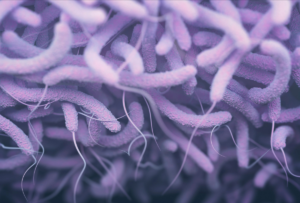
Sustainability starts with health: Disease prevention and management in aquaculture
Let’s continue the conversation on sustainable aquaculture. This is the third blog in our series exploring the sustainability of aquaculture—what we currently know, emerging advancements, and areas for growth. In our previous, we covered escapes in aquaculture, and before that, we discussed aquaculture feed.
In this blog, we are focusing on diseases in aquaculture. Much like terrestrial crop and livestock production systems, aquaculture—the practice of farming seafood—contends with the risk of disease. More so than on land, the aquatic environment facilitates the spread of pathogens within farms and out to the surrounding environment. This is a serious concern for the aquaculture industry, with disease burden being recognized as the most significant constraint to the global growth of aquaculture.
It is not fully understood how expanding U.S. aquaculture into federal waters (3-200 nautical miles), will impact disease prevalence and treatment. On one hand, the open ocean environment provides space for healthier stocking densities and pen spacing, with reduced contact with wild animals. On the other hand, it is more challenging to access open ocean pens for health inspections and treatments. So, what do we know so far? Let’s dive into the details.
This is also the subject of our recently published white paper, “Sustainability Considerations for the Expansion of US Aquaculture: Preventing and Managing Disease,” which we invite you to read for a more in-depth look at the issue.
What are the risks?
Containing, treating, and, worst of all, losing animals to disease is tremendously costly to the aquaculture industry. Globally, lost revenue due to aquaculture parasites has been estimated at up to 10 billion USD annually, and disease accounted for 20% of total insurance losses in the salmon farming industry from 1992-2012. Additionally, diseases may spread to wild populations, although the population-level impacts on wild stocks are unclear.
Excessive use of antibiotics to treat or prevent disease in aquaculture poses significant health and sustainability challenges. Overuse of antibiotics contributes to antimicrobial resistance, a serious global health threat. Moreover, people can suffer adverse health impacts when coming into contact with antibiotics or residues while administering medicines on farms or consuming treated fish.
Researchers estimate that over 70% of antibiotics administered via fish feed diffuse into the surrounding environment, where they can harm microbial biodiversity and be consumed by wild fish, with food safety implications for wild-capture fisheries.
Best practices to prevent, manage, and treat disease
Best practices for disease management involve a three-tiered approach, ideally using a combination of strategies tailored to the specific cultivated species and site.
- Having plans and protocols in place to manage and respond to disease. Practical and effective biosecurity (fish health) plans are fundamental for preventing the introduction and spread of pathogens in aquaculture. An effective biosecurity plan would train staff to identify diseases, describe specific actions to prevent and mitigate disease risks, and define how risk management is communicated, such as via Standard Operating Procedures and regular staff training.
- Implementing proactive strategies to prevent disease. These strategies include farm design and husbandry practices to maintain animal health, vaccination, and selective breeding for disease resistance.
- Treatment of disease with antibiotics or other therapeutics. Antimicrobial products can be used both as disinfectants and as therapeutics for disease treatment. Due to a troubling rise in antimicrobial resistance, these are considered the last line of defense and should be carefully and appropriately used. The U.S. Food and Drug Administration (FDA) has approved three antibiotics available for use in aquaculture, with veterinary prescription: oxytetracycline, florfenicol, and sulfadimethoxine/ormetoprim.
Alternatives to antibiotics
Emerging research in fish immune system function and pathogen virulence has led to innovative, targeted treatments that can rapidly address specific pathogens without risk of developing resistance.
Antimicrobial peptides, naturally produced by fish immune systems, provide a rapid, broad-spectrum response to a variety of pathogens. Antivirulence therapies target the specific pathways by which pathogens cause disease, only eliminating pathogens that could be virulent, unlike traditional antibiotics that indiscriminately kill both pathogens and beneficial microbes. Both antimicrobial peptides and antivirulence therapies carry significantly less risk of creating antimicrobial resistance and appear promising for use in aquaculture.
However, federal approval processes for new therapeutics are extremely slow. Scholars and farmers are also recognizing Indigenous and traditional practices that can improve fish health while providing ecological co-benefits. These practices can include integrating native aquatic vegetation to enhance nutrition and water quality, using traditional medicinal plants to improve fish health, and co-cultivating “cleaner fish” that eat common parasites.
Recommendations to advance sustainable US aquaculture
For federal regulators:
- The National Oceanic and Atmospheric Administration (NOAA) and the U.S. Department of Health and Human Services (HHS) should coordinate with industry to identify priority native, cultivatable species and diseases for pharmaceutical, vaccine, and antimicrobial research.
- The FDA should explore expediting development and licensing processes for aquaculture vaccines and therapeutants, including Investigational New Animal Drug approvals.
For Congress:
- Direct NOAA and the U.S. Department of Agriculture (USDA) to create coordinated aquaculture biosecurity research programs, including for breeding methods, diet, and pathogen dynamics.
- Establish biosecurity standards based on findings from coordinated research led by NOAA and USDA.
- Expand capacity for aquaculture disease diagnosis and treatment, including qualified laboratory facilities and trained health personnel.
We’re approaching the end of our series on the sustainability of aquaculture. In the fourth and final blog, we will summarize what we’ve learned and examine the role of technology in making aquaculture sustainable.












